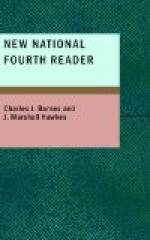Sure enough, an Indian was seated in the other chair, and he and father were talking with great animation.
The Indian was of a stout build, and wore a straw hat with a broad, red band around it; he had on a fine, black broad-cloth coat, but his trousers were shabby and his shoes were pretty well worn.
His face was bright and intelligent, and I watched it very closely as he talked in his earnest way with father, who was equally animated in answering him.
The Indian carried a rifle and a revolver—the latter being in plain sight at his waist—but I never connected the thought of danger with him as he sat there talking with father.
I describe this Indian rather closely, as he was no other than the well-known chief, Little Crow, who was at the head of the frightful Sioux war, which broke out within sixty days from that time.
The famous chieftain staid until the sun went down. Then he started up and walked away rapidly in the direction of Lac Qui Parle. Father called good-by to him, but he did not reply and soon disappeared in the woods.
The sky was cloudy, and it looked as if a storm was coming; so, as it was dark and blustering, we remained within doors the rest of the evening. A fine drizzling rain began to fall, and the darkness was intense.
The evening was well advanced, and father was reading to us, when there came a rap upon the door.
It was so gentle and timid that it sounded like the pecking of a bird, and we all looked in the direction of the door, uncertain what it meant.
“It is a bird, scared by the storm,” said father, “and we may as well admit it.”
I sat much nearer the door than either of my parents, and instantly started up and opened it. As I did so, I looked out into the gloom, but sprung back the next moment with a low cry of alarm.
“What’s the matter?” asked father, hastily laying down his book and walking rapidly toward me.
“It isn’t a bird; it’s a person.” As I spoke, a little Indian girl, about my own age, walked into the room, and looking in each of our faces, asked in the Sioux language whether she could stay all night.
I closed the door and we gathered around her. She had the prettiest, daintiest moccasins, but her limbs were bare from the knee downward. She wore a large shawl about her shoulders, while her coarse, black hair hung loosely below her waist.
Her face was very pretty, and her eyes were as black as coal and seemed to flash fire whenever she looked upon any one.
Of course, her clothing was dripping with moisture, and her call filled us all with wonder. She could speak only a few words of English, so her face lighted up with pleasure when father addressed her in the Sioux language.
As near as we could find out, her name was Chitto, and she lived with her parents at Lac Qui Parle. She told us that there were several families in a spot by themselves, and that day they had secured a quantity of strong drink, of which they were partaking very freely.




